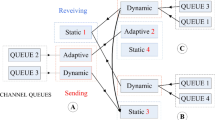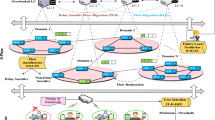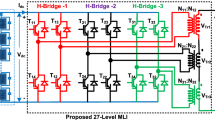Abstract
In this paper, a bipartite model for load balancing (LB) in grid computing environments, called Transverse viewpoint-based Bi-Tier model (TBT), is proposed. TBT can efficiently eliminate topology mismatching between overlay- and physical-networks during the load transfer process. As an implementation of TBT, a novel LB policy called M2ON (Min-cost and Max-flow Channel based Overlay Network) is presented. In M2ON, the communication capability is denoted as M2C (Min-cost and Max-flow Channel) which is obtained using a Labeled Tree Probing (LTP) method. The computing capacity is denoted as the Idle Factor (IF) which is obtained from the semantic overlay. The higher- and lower-level characteristics are combined into an Integrated Impacting Factor (IIF) using a Double Linear Inserting (DLI) function. Based on IIF, optimal topology matching can be achieved in the LB process. Extensive experiments and simulations have been performed and will be discussed. The results show that M2ON achieves more accurate topology matching with a minimum increment in the overall locating time yet achieving higher system performance as a whole.
Similar content being viewed by others
References
Rao N. Overlay networks of in situ instruments for probabilistic guarantees on message delays in wide-area networks. IEEE Journal on Selected Areas in Communications, 2004, 22(1): 79–81
Lin H C, Raghavendra C S. A dynamic load balancing policy with a central job dispatcher (LBC). IEEE Transactions on Software Engineering, 1992, 18(2): 148–158
Shivaratri N G, Krueger P, Singhal M. Load distributing for locally distributed systems. Computer Communication, 1992, 8: 33–44
Zeng Z, Veeravalli B. On the design of distributed object placement and load balancing strategies in large-scale networked multimedia storage systems. IEEE Transactions Parallel and Distributed Systems, 2008, 20(3): 369–383
Dhakal S, Hayat M, Jorge E, et al. Dynamic load balancing in distributed systems in the presence of delays: a regeneration-theory approach. IEEE Transaction on Parallel and Distributed System, 2007, 18(4): 485–498
Jacques M, Couturier, Dynamic R. Load balancing and efficient load estimators for asynchronous iterative algorithms. IEEE Transactions Parallel and Distributed Systems, 2005, 16(4): 289–300
Cao J. Self-Organizing Agents for grid load balancing. In: Proceedings of the Fifth IEEE/ACM International Workshop on Grid Computing, 2004, 388–395
Giannacopoulos D. Optimal discretization based load balancing for parallel adaptive finite element electromagnetic analysis. IEEE Transactions on Magnetics, 2004, 40(2): 977–1001
Kim C, Kameda H. An algorithm for optimal static load balancing in distributed computer systems. IEEE Transactions on Computers, 1992, 41: 381–384
Grosu D, Chronopoulos A. A game theoretic model and algorithm for load balancing in distributed systems. In: Proceedings of 16th International Parallel & Distributed Symposium, April. 2002, 15–19
Li J, Kameda H. Load balancing problems for multiclass jobs in distributed/parallel computer systems. IEEE Transactions on Computers and Mathematics with Applications, 1998, 47(3): 322–332
Tantawi A N, Towsley D. Optimal static load balancing in distributed computer systems. Journal of ACM, 1985, 32(2): 445–465
Li J, Kameda H. Optimal static load balancing of multi-class jobs in a distributed computer system. In: Proceedings of 10th International Conference on Distributed Computing Systems, 1990: 562–569
Zeng Z, Bharadwaj V. Design and analysis of a non-preemptive decentralized load balancing algorithm for multi-class jobs in distributed networks. Computer Communication, 2004, 27: 679–694
Grosu D, Chronopoulos A T. Algorithmic mechanism design for load balancing in distributed systems. IEEE Transactions on Systems, Man and Cybernetics-Part B: Cybernetics, 2004, 34(1): 134–143
Lu K, Subrata R, Zomaya A Y. Towards decentralized load balancing in a computational grid environment. In: Proceedings of 1st International Conference on Grid and Pervasive Computing (GPC’06), 2006
Lu K, Subrata R, Zomaya A Y. An efficient load balancing slgorithm for heterogeneous grid systems considering desirability of grid sites. In: Proceedings of 25th IEEE International Performance Computing and Communications Conference, Phoenix, Arizona, USA, 2006
Anand L, Ghose D, Mani V. ELISA: An sstimated load information scheduling algorithm for distributed computing system. Computers and Mathematics with Applications, 1999, 37: 57–85
Evans D, Butt W. Dynamic Load balancing using task-transfer probabilities. Parallel Computing, 1993, 19: 279–301
Walshaw C, Berzins M. Dynamic load-blancing for PDE solvers on adaptive unstructured meshes. Concurrency: Practice and Experience, 1995, 7: 17–28
Watts J, Taylor S. A practical approach to dynamic load balancing. IEEE Transactions on Parallel and Distributed Systems, 1998, 9(3): 235–248
Zhang Y, Kameda H, Shimizu K. Adaptive bidding load balancing algorithms in heterogeneous distributed systems. In: Proceedings of IEEE 2nd International Workshop Modeling, Analysis, and Simulation of Computer and Telecomm. Systems, 1994, 250–254
Fatta G, Berthold M R. Dynamic load balancing for the distributed mining of molecular structures. IEEE Transactions on Parallel and Distributed Systems, 2006, 17(8): 773–786
Zhang Y, Franke H, Moreira J. An integrated approach to parallel scheduling using gang scheduling, backfilling, and migration. IEEE Transactions on Parallel and Distributed Systems, 2003, 14(3): 236–247
Akay O, Erciyes K. A dynamic load balancing model for a distributed system. Mathematical and Computational Applications, 2003, 8(3): 353–360
Boeres C, Lima A, Rebello V E F. Hybrid task scheduling: integrating static and dynamic heuristics. In: Proceedings of 15th Symposium on Computer Architecture and High Performance Computing, São Paulo, Brazil, 2003: 199–206
Avvenuti M, Rizzo L, Vicisano L. A hybrid approach to adaptive load sharing and its performance. Journal of Systems Architecture, 1997, 42: 679–696
Cao J, Spooner D P, Jarvis S A, et al. Agent-based grid load balancing using performance-driven task scheduling. In: Proceedings of the International Parallel and Distributed Processing Symposium, 2003, 49.2
Subrata R, Zomaya A Y, Landfeldt B. Game theoretic approach for load balancing in computational grids. IEEE Transactions on Parallel and Distributed Systems, 2007, 18(2): 23–26
Salehi M A, Deldari H. Grid load balancing using an echo system of intelligent ants. In: Proceedings of the 24th IASTED International Multi-Conference on Parallel and Distributed Computing and Networks, 2006, 14(16): 47–53
Mello R F D, Senge L G E, Yang L T. A routing load balancing policy for grid computing environments. In: Proceedings of the 20th International Conference on Advanced Information Networking and Applications, 2006
Mello R F D, Filho J A, Senger L J, et al. RouteGA: a grid load balancing algorithm with genetic support. In: Proceedings of 21st International Conference on Advanced Networking and Applications, 2007, 885–892
Bridgewater J, Boykin P, Roychowdhury V P. Balanced overlay networks (BON): an overlay technology for decentralized load balancing. IEEE Transaction on Parallel and Distributed System, 2007, 18(8): 1122–1134
Carra D, Cigno R L, Biersack E. Stochastic Graph processes for performance evaluation of content delivery applications in overlay networks. IEEE Transaction on Parallel and Distributed System, 2007, 19(2): 247–261
Darieby M, Petriu D, Rolia J. Load-balancing data traffic among tnterdomain links. IEEE Journal on Selected Areas in Communications, 2007, 25(5): 67–76
Liu Y H, Xiao L, Ni L M. Building a scalable bipartite P2P overlay network. IEEE Transaction on Parallel and Distributed System, 2007, 18(9): 1296–1307
David H B, Kaashoek F, Robert M. Resilient overlay networks. In: Proceedings of 18th ACM Symposium on Operating Systems Principles (SOSP) October Banff, Canada., 2001: 131–145
Savage S, Anderson T, Aggarwal A, et al. Detour: informed internet routing and transport. IEEE Micro, 1999, 19(1): 50–59
Hou Y T, Duan Z, Zhang Z. Service overlay networks: SLA, QoS and bandwidth provisioning. In: Proceedings of International Conference on Network Protocols, 2002: 11–17
Matthews W, Cottrell L. The Ping ER project: active internet performance monitoring for the NENP community. IEEE Communication Magazine, May 2000: 130–136
Balakrishnan H, Padmanabhan V N, Seshan S, et al. TCP behavior of a busy internet server: analysis and improvements. In: Proceedings of IEEE INFOCOM, 1998, 1: 252–262
Vogel R, Herrtwich R G, Kalfa W, et al. QoS based routing of multimedia streams in computer networks. IEEE Journal of Selected Areas Communication, 1996, 14: 1235–1244
Wang Z, Crowcroft J. QoS routing for supporting resource reservation. IEEE Journal of Selected Areas Communication, 1996, 14: 1228–1234
Murthy S, Garcia J. Congestion oriented shortest multipath routing. In: Proceedings of Computer Communications, 1996. 3: 1028–1036
Rao N S V, Batsell S G. QoS routing via multiple paths using bandwidth reservation. In: Proceedings of Conference. Computer Communications, 1998. 1: 11–18
Wang H, Poo G S. Load balancing in the provisioning of hose model virtual private networks with multi-path routing. IET Communication, 2007, 4(1): 684–692
John Z T, Chiasson J, Ghanem J, et al. The effect of time delays on the stability of load balancing algorithms for parallel computations. IEEE Transactions on Control Systems Technology, 2005, 13(6): 932–943
Ruchir Shah B V M. On the design of adaptive and decentralized load-balancing algorithms with load estimation for computational grid environments. IEEE Transactions on Parallel and Distributed Systems, 2007, 18(12): 1675–1686
Liu Y H, Liu X, Xiao L, et al. Location-aware topology matching in P2P systems. In: Proceedings of the 23th Annual Joint Conference of the IEEE Computer and Communications Societies, 2004, 4: 2220–2230
Huang Y, Jin B, Cao J. A distributed approach to construction of topology mismatching aware P2P overlays in wireless ad hoc networks. In: Proceedings of 14th Euromicro International Conference on Parallel, Distributed, and Network Based Processing, 2006: 340–347
Liu Y H, Zhuang Z, Xiao L, et al. A distributed approach to solving overlay mismatching problem. In: Proceedings of 24th International Conference on Distributed Computing Systems, 2004: 132–139
Liu Y H. A Two-hop solution to solving topology mismatch. IEEE Transactions on Parallel and Distributed Systems, 2008, 19(11): 1591–1601
Bridgewater J S A, Boykin P O, Roychowdhury V P. Statistical mechanical load balancer for the web. Physical Reviewer, 2005, E (71): 046133
Li M, Liu F, Ren F Y. Routing strategy on a two-dimensional smallworld network model. Physical Reviewer, 2007 E (75): 066115
IAkyildiz I F. Wireless sensor networks: a survey, Computer Networks, 2002, 38(3): 393–422
Steele J M. Gibbs’ Measures on combinatorial objects and the central limit theorem for an exponential family of random trees. Probability in the Engineering and Informational Sciences, 1, 1987: 47–59
Elias P, Feinstein A, Shannon C E. A note on the maximum flow through a network. IRE Transactions on Information Theory, 1956: 117–121
Cheung T Y. Graph traversal techniques and the maximum flow problem in distributed computation. IEEE Transactions on Software Engineering, 1983, 9(4): 504–512
Ramamoorthy A, Shi J, Wesel R D. On the capacity of network coding for random networks. IEEE Transactions on Information Theory, 2005, 51(8): 2878–2886
Dunn D A, Grover W D, MacGregor M H. Comparison of k-shortest paths and maximum flow routing for network facility restoration. IEEE Journal on Selected Areas in Communications, 1994, 12(1): 88–100
Hu T C. Integer Programming and Network Flows. Addison-Wesley, 1969
Skienna S. Implementing Discrete Mathematics: Combinatorics and Graph Theory with Mathematics. Redwood city. CA: Addison-Wesley, 1990
Dunn D A, Grover Q D, Macgregor M H. Development and use of a random network synthesis tool with controlled connectivity statistics. TRLabs, Representative of the University of Alberta. WP-90-10, 1990
Author information
Authors and Affiliations
Corresponding author
Rights and permissions
About this article
Cite this article
Jiang, W., Baumgarten, M., Zhou, Y. et al. A bipartite model for load balancing in grid computing environments. Front. Comput. Sci. China 3, 503–523 (2009). https://doi.org/10.1007/s11704-009-0036-0
Received:
Accepted:
Published:
Issue Date:
DOI: https://doi.org/10.1007/s11704-009-0036-0




